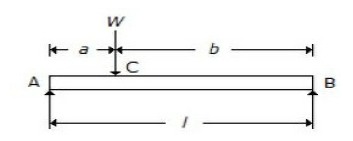The temperature at which the volume of a gas becomes zero is called
Absolute scale of temperature
Absolute zero temperature
Absolute temperature
None of these
Correct Answer :
B. Absolute zero temperature
Related Questions
Steam coal is a
Pulverised coal
Brown coal
Coking bituminous coal
Non-coking bituminous coal
A thin cylindrical shell of diameter (D) and thickness (t) is subjected to an internal pressure (p). The ratio of longitudinal strain to volumetric strain is
(m - 1)/ (2m - 1)
(2m - 1)/ (m - 1)
(m - 2)/ (3m - 4)
(m - 2)/ (5m - 4)
When a closely-coiled helical spring of mean diameter (D) is subjected to an axial load (W), the stiffness of the spring is given by
Cd⁴/D3n
Cd⁴/2D3n
Cd⁴/4D3n
Cd⁴/8D3n
The shear force diagram of a cantilever beam of length l and carrying a uniformly distributed load of w per unit length will be
A right angled triangle
An isosceles triangle
An equilateral triangle
A rectangle
Which of the following is an intensive property of a thermodynamic system?
Volume
Temperature
Mass
Energy
For a beam, as shown in the below figure, when the load W is applied in the centre of the beam, the maximum deflection is

Wl3 / 48EI
5Wl3 / 384EI
Wl3 / 392EI
Wl3 / 384EI
The efficiency of Joule cycle is
Greater than Carnot cycle
Less than Carnot cycle
Equal to Carnot cycle
None of these
A steel bar of 5 mm is heated from 25°C to 45°C and it is free to expand. The bar will induce
No stress
Shear stress
Tensile stress
Compressive stress
In an extensive property of a thermodynamic system
Extensive heat is transferred
Extensive work is done
Extensive energy is utilised
None of these
Diesel cycle consists of __________ processes.
Two constant volume and two isentropic
Two constant pressure and two isentropic
Two constant volume and two isothermal
One constant pressure, one constant volume and two isentropic
The maximum diameter of the hole that can be punched from a plate of maximum shear stress 1/4th of its maximum crushing stress of punch, is equal to (where t = Thickness of the plate)
t
2t
4t
8t
One kg of carbon monoxide requires 4/7 kg of oxygen and produces
11/3 kg of carbon dioxide gas
7/3 kg of carbon monoxide gas
11/7 kg of carbon dioxide gas
8/3 kg of carbon monoxide gas
A beam which is fixed at one end and free at the other is called
Simply supported beam
Fixed beam
Overhanging beam
Cantilever beam
Efficiency of a riveted joint is the ratio of its strength (max. load it can resist without failure) to the strength of the un-punched plate in
Tension
Compression
Bearing
Any one of the above
The strain energy stored in a solid circular shaft subjected to shear stress (τ), is: (Where G = Modulus of rigidity for the shaft material)
τ²/ 2G × Volume of shaft
τ/ 2G × Volume of shaft
τ²/ 4G × Volume of shaft
τ/ 4G × Volume of shaft
A cycle consisting of one constant pressure, one constant volume and two isentropic processes is known as
Carnot cycle
Stirling cycle
Otto cycle
Diesel cycle
The fuel mostly used in cement industry and in metallurgical processes is
Wood charcoal
Bituminous coke
Pulverised coal
Coke
Stirling and Ericsson cycles are
Reversible cycles
Irreversible cycles
Semi-reversible cycles
Quasi-static cycles
The value of cp/cv for air is
1
1.4
1.45
2.3
The neutral axis of a transverse section of a beam passes through the centre of gravity of the section and is
In the vertical plane
In the horizontal plane
In the same plane in which the beam bends
At right angle to the plane in which the beam bends
Strain is equal to (where l = Original length, and δl = Change in length)
l/δl
δl/l
l.δl
l + δl
The mass of excess air supplied is equal to
(23/100) × Mass of excess carbon
(23/100) × Mass of excess oxygen
(100/23) × Mass of excess carbon
(100/23) × Mass of excess oxygen
The pull required to crush the rivet per pitch length is
p.t.σt
d.t.σc
π/4 × d² × σt
π/4 × d² × σc
A hollow shaft of same cross-section area as compared to a solid shaft transmit
Same torque
Less torque
More torque
Unpredictable
The entropy of water at 0°C is assumed to be
1
0
-1
10
In open cycle gas turbine plants
The indirect heat exchanger and cooler is avoided
Direct combustion system is used
A condenser is used
All of the above
Diamond riveted joint can be adopted in the case of following type of joint
Butt joint
Lap joint
Double riveted lap joints
All types of joints
The efficiency of Carnot cycle is maximum for
Gas engine
Petrol engine
Steam engine
Reversible engine
Shear stress induced in a shaft subjected to tension will be
Maximum at periphery and zero at center
Maximum at center
Uniform throughout
None of the above
Which of the following is correct?
Absolute pressure = Gauge pressure + Atmospheric pressure
Gauge pressure = Absolute pressure + Atmospheric pressure
Atmospheric pressure = Absolute pressure + Gauge pressure
Absolute pressure = Gauge pressure - Atmospheric pressure
